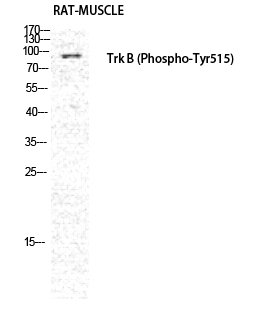Phospho Trk B (Y705) Cell-Based Colorimetric ELISA Kit
- Catalog No.:KA1188C
- Applications:ELISA
- Reactivity:Human;Mouse;Rat
- Gene Name:
- NTRK2
- Human Gene Id:
- 4915
- Human Swiss Prot No:
- Q16620
- Mouse Swiss Prot No:
- P15209
- Rat Swiss Prot No:
- Q63604
- Storage Stability:
- 2-8°C/6 months
- Other Name:
- BDNF/NT-3 growth factors receptor (EC 2.7.10.1) (GP145-TrkB) (Trk-B) (Neurotrophic tyrosine kinase receptor type 2) (TrkB tyrosine kinase) (Tropomyosin-related kinase B)
- Detection Method:
- Colorimetric
- Background:
- alternative products:Additional isoforms seem to exist,catalytic activity:ATP + a [protein]-L-tyrosine = ADP + a [protein]-L-tyrosine phosphate.,function:Receptor for brain-derived neurotrophic factor (BDNF), neurotrophin-3 and neurotrophin-4/5 but not nerve growth factor (NGF). Involved in the development and/or maintenance of the nervous system. This is a tyrosine-protein kinase receptor. Known substrates for the TRK receptors are SHC1, PI-3 kinase, and PLC-gamma-1.,PTM:Ligand-mediated auto-phosphorylation.,similarity:Belongs to the protein kinase superfamily. Tyr protein kinase family.,similarity:Belongs to the protein kinase superfamily. Tyr protein kinase family. Insulin receptor subfamily.,similarity:Contains 1 protein kinase domain.,similarity:Contains 2 Ig-like C2-type (immunoglobulin-like) domains.,similarity:Contains 2 LRR (leucine-rich) repeats.,subunit:Exists in a dynamic equilibrium between monomeric (low affinity) and dimeric (high affinity) structures. Binds SH2B2. Interacts with SQSTM1 and KIDINS220.,tissue specificity:Isoform TrkB is widely expressed, mainly in the nervous tissue. In the CNS, expression is observed in the cerebral cortex, hippocampus, thalamus, choroid plexus, granular layer of the cerebellum, brain stem, and spinal cord. In the peripheral nervous system, it is expressed in many cranial ganglia, the ophtalmic nerve, the vestibular system, multiple facial structures, the submaxillary glands, and dorsal root ganglia. Isoform TrkB-T1 is expressed in multiple tissues, mainly in brain, pancreas, kidney and heart. Isoform TrkB-T-Shc is predominantly expressed in brain.,
- Function:
- blood vessel development, vasculogenesis, eye development, eye photoreceptor cell differentiation, vasculature development, generation of a signal involved in cell-cell signaling, regulation of nucleotide metabolic process, protein amino acid phosphorylation, phosphorus metabolic process, phosphate metabolic process, cell surface receptor linked signal transduction, enzyme linked receptor protein signaling pathway, transmembrane receptor protein tyrosine kinase signaling pathway, activation of adenylate cyclase activity, cell-cell signaling, sensory organ development,behavior, feeding behavior, positive regulation of cell communication, regulation of neuron projection development,glutamate secretion, phosphorylation, neuron differentiation, regulation of cyclic nucleotide metabolic process,regulation of cyclic nucleotide biosynthetic process, regulation of nucleotide biosynthetic process
- Subcellular Location:
- Cell membrane ; Single-pass type I membrane protein . Endosome membrane ; Single-pass type I membrane protein . Early endosome membrane . Cell projection, axon . Cell projection, dendrite . Cytoplasm, perinuclear region . Cell junction, synapse, postsynaptic density . Internalized to endosomes upon ligand-binding. .
- Expression:
- Isoform TrkB is expressed in the central and peripheral nervous system. In the central nervous system (CNS), expression is observed in the cerebral cortex, hippocampus, thalamus, choroid plexus, granular layer of the cerebellum, brain stem, and spinal cord. In the peripheral nervous system, it is expressed in many cranial ganglia, the ophthalmic nerve, the vestibular system, multiple facial structures, the submaxillary glands, and dorsal root ganglia. Isoform TrkB-T1 is mainly expressed in the brain but also detected in other tissues including pancreas, kidney and heart. Isoform TrkB-T-Shc is predominantly expressed in the brain.
- June 19-2018
- WESTERN IMMUNOBLOTTING PROTOCOL
- June 19-2018
- IMMUNOHISTOCHEMISTRY-PARAFFIN PROTOCOL
- June 19-2018
- IMMUNOFLUORESCENCE PROTOCOL
- September 08-2020
- FLOW-CYTOMEYRT-PROTOCOL
- May 20-2022
- Cell-Based ELISA│解您多样本WB检测之困扰
- July 13-2018
- CELL-BASED-ELISA-PROTOCOL-FOR-ACETYL-PROTEIN
- July 13-2018
- CELL-BASED-ELISA-PROTOCOL-FOR-PHOSPHO-PROTEIN
- July 13-2018
- Antibody-FAQs


